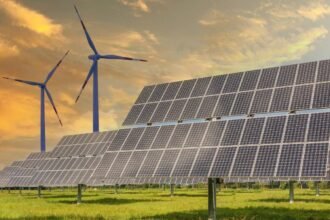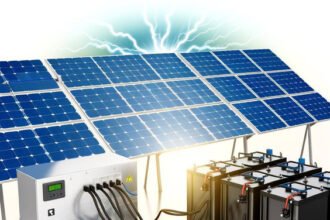Last Updated on November 1, 2025 by Author
India’s journey to achieve net zero emissions by 2070 is not just an environmental goal—it’s an economic transformation. As the world’s third-largest energy consumer, India’s transition to renewables has the potential to generate millions of jobs, boost exports, and reshape industries for a sustainable future.
Renewable Energy: The Backbone of Net Zero
India’s commitment to non-fossil fuel energy capacity—targeting 500 GW by 2030—reflects the nation’s ambitious climate roadmap. Solar, wind, hydro, and bioenergy are the cornerstones of this strategy, collectively reducing dependence on coal while ensuring energy security for a rapidly growing economy.
The government’s focus on “Panchamrit”—a five-point climate action plan announced at COP26—has further accelerated the integration of clean energy across sectors.
Solar Energy: The Rising Star of India’s Energy Mix
Solar power continues to dominate India’s renewable expansion. Massive projects like Bhadla Solar Park (Rajasthan) and Pavagada Solar Park (Karnataka) demonstrate how large-scale solar capacity is driving clean power accessibility.
The decreasing cost of photovoltaic modules, improved efficiency of bifacial panels, and the PM-KUSUM scheme for solar irrigation pumps are empowering both rural and urban India. By 2030, solar alone could account for over 50% of India’s renewable capacity.
Wind Energy: Harnessing Nature’s Force
India ranks fourth globally in wind power generation. With strong wind corridors in Tamil Nadu, Gujarat, and Maharashtra, the sector is witnessing renewed momentum through hybrid wind-solar projects and repowering initiatives that replace older turbines with more efficient ones.
Offshore wind potential—estimated at over 70 GW—is also being explored, with early-stage projects along the Gujarat coast expected to be operational later this decade.
Green Hydrogen: The Fuel of the Future
As industries face mounting pressure to decarbonize, green hydrogen is emerging as a key enabler of India’s net zero ambitions. The National Green Hydrogen Mission is promoting hydrogen as a clean alternative for steel, transport, and fertilizer production.
With abundant renewable resources and competitive production costs, India is poised to become a major exporter of green hydrogen to Europe and East Asia, strengthening its role in the global clean energy economy.
Electric Mobility and Smart Energy Systems
India’s transition to electric mobility is closely linked with renewable power generation. Solar-powered EV charging networks are expanding across highways, commercial complexes, and housing societies. Smart grids and digital power management systems ensure stable integration between renewable supply and consumer demand.
Advanced analytics and AI-powered forecasting are also optimizing grid operations, improving reliability, and minimizing curtailment of renewable output.
Rural Empowerment and Job Creation
Renewable energy isn’t just transforming cities—it’s revitalizing India’s villages. Decentralized solar microgrids and biomass plants are bringing electricity to remote regions, enabling new businesses, schools, and healthcare services.
According to IRENA, India’s clean energy transition could create over 3.5 million new jobs by 2030 across manufacturing, installation, and maintenance sectors. This growth not only drives sustainability but also contributes directly to economic inclusion and national development.
Financing the Green Transition
Green finance has become a critical enabler of India’s clean energy push. The issuance of sovereign green bonds, international partnerships, and private equity inflows are fueling large-scale renewable projects.
Moreover, initiatives like green credit trading and carbon markets are incentivizing companies to invest in emission-reducing technologies. India’s leadership in green financing is positioning it as an attractive destination for global climate capital.
Challenges on the Road to Net Zero
While progress is strong, challenges remain. Land acquisition, grid modernization, and intermittency issues require coordinated solutions. Upgrading transmission infrastructure and implementing robust storage technologies are vital for balancing renewable supply with national demand.
Policy consistency and faster approval mechanisms will also be key to accelerating deployment and investor confidence.
The Path Ahead
India’s path to net zero is more than an environmental mission—it’s a blueprint for sustainable economic transformation. The synergy between technology, policy, and private innovation will determine the pace of progress.
With continued investment in renewables, smart infrastructure, and clean mobility, India is not just reducing emissions—it’s redefining growth itself.
Conclusion
The net zero journey represents India’s biggest opportunity of the 21st century. By embracing renewable energy, the nation is powering inclusive growth, ensuring energy independence, and setting a global example of how economic development and environmental stewardship can go hand in hand.









